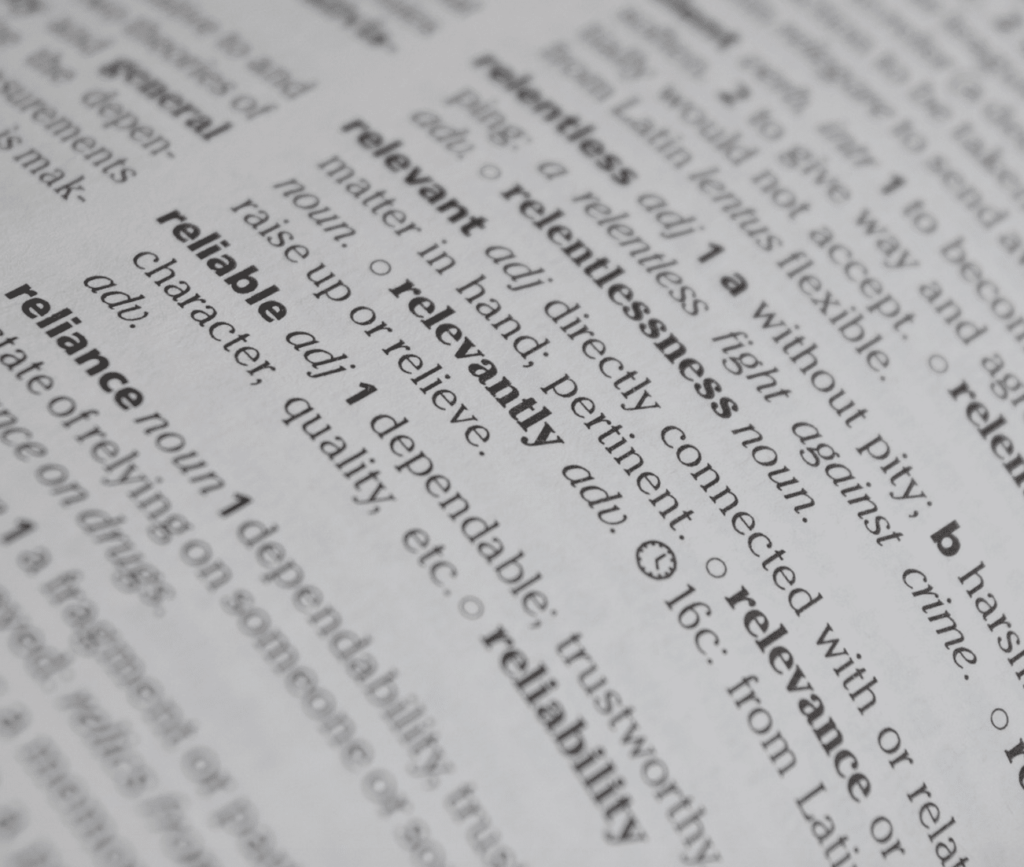A group of us at Bilinguistics recently reviewed our speech-language evaluation report template to evaluate the language and wording to ensure that we are using bias free language. Language changes over time and it’s important for us as practitioners to be mindful of the changes and to ensure that we use appropriate, respectful, and culturally responsive terminology in our reports. We want to use words that are accurate, clear, and free from bias or prejudice.
As we set about to revise our report template, we explored writing guides to better understand bias free language. We’ll share here some of the important elements for using clear language that is relevant and free of bias.
Include relevant information and don’t include non-relevant information

Think about what matters for your end goal. You are reporting on speech and language skills so talk about things that are relevant to your purpose. When describing a client, student, or their family, describe only relevant characteristics. While we can include information about age, disability, gender identity, cultural background, socioeconomic status, and so forth without bias, we need to think about whether that information is relevant to our report.
For example, I recently received records on a student I was testing and in a previous report that was in his folder, it said, “Henry is a 9-year-old Hispanic male.” Relevant? Not really. Here are some questions to ask in this case.
- Does the use of the descriptor “Hispanic” add value to this report?
- Is it information we need?
- Will we do anything differently in our testing or analysis because of it?

No. No. and No. Now, you might argue that knowing that he is Hispanic lets you know that you should be aware of possible use of Spanish or another language. And you’d have a point. BUT, why not just include THAT information? “Henry is a 9-year-old boy who has been exposed to both English and Spanish throughout his life.” Being Hispanic does not mean that you have been exposed to Spanish, nor does not being Hispanic mean you have not been exposed to Spanish. If language or dialect use is the information you want to convey, state it clearly.
Be Specific
Once you have decided which characteristics are relevant to include, describe them as specifically as possible. Let’s take a look at ways we can talk about age, disability, cultural background, and socioeconomic status.
How do we describe age?
As speech-language pathologists, we get very specific about age, right down to the months. How, though, should we refer to our students or clients beyond that? Using information from the APA and the CDC, here are the guidelines.
| Age | Bias Free Age Terminology per APA, CDC |
| Birth to 1 year of age | Infant |
| 1-to-2 years of age | Toddler |
| Up to 12 years of age | Child, Boy, Girl |
| 13-17 years of age | Adolescent, Young Person/Woman/Man |
| 18 years of age or older | Adult, Man, Woman |
How do we talk about disabilities with bias free language?
When talking about disabilities, use names of conditions rather than categories of conditions to be more specific. For example, “Alzheimer’s disease” is more specific than “dementia” and “Fragile X Syndrome” is more specific than “a genetic disorder.” Also, when writing about a syndrome, use the full name of the syndrome–“Simon has Down Syndrome” not “Simon has Down’s.”
When writing about disabilities, it is most acceptable to use person-first language (e.g. “person with intellectual disability” rather than “an intellectually disabled person”). While person-first language is the norm, there are some groups with different preferences. For example, many in the autism community prefer identity-first language, such as “autistic person.” The Autistic Self Advocacy Network wrote a great piece on Identity-First Language, if you want to explore it further. When we are writing a speech-language report, we are writing about an individual. Ask that individual or their family members what their preferred terminology is.
Is cultural background relevant?
I say cultural background is absolutely relevant. Understanding what a student’s or client’s experiences have been, including where they have lived, what languages are used in their home and community, and what their educational experience has looked like is critical to our diagnostic decisions and our intervention, and therefore a relevant part of our reports.
How do we talk about cultural background using bias free language?

Again, we need to be specific and relevant. As we discussed above with the example of Henry, race is not as descriptive as cultural experience. If we describe a student as Black, we cannot assume they speak African American English. So we have to ask ourselves–What is relevant for our reports. The use of a dialect is relevant to our evaluation so we should specifically state information about dialect use based on our observations and child and family input, and make no assumptions about language or dialect use based on race. We also want to be mindful to use culturally sensitive language. Too many times, I have seen people refer to the use of dialect as “wrong” or “incorrect grammar.” Accept and value the dialects your students use and write about them descriptively.
Here is a blurb I pulled from a report of a child who used African American English dialect:
“Features of African-American English dialect were present in Bella’s language sample. Examples include, ‘him book,’ ‘she bes mean’ and ‘them get dirty’. These are features that are consistent with Bella’s home dialect. They are not errors and are not indicative of a language disorder.”
If a child has recently moved to the United States from another country, state the specific country, not just the region. Include information about how long they lived in that country and their age when they moved. Share what languages they were exposed to before moving and after moving. Talk about the languages used in their educational experiences. One thing I have seen in some reports is inclusion of citizenship information. I would argue that is not relevant.
Instead of saying, “Tristan’s parents are Venezuelan citizens who moved to the United States two years ago,”
say, “Tristan and his family lived in Venezuela the first 4 years of his life before moving to the United States. Spanish continues to be the primary language spoken in the home. Since moving to the United States two years ago, Tristan has been enrolled in a dual language program in which both Spanish and English are used throughout his day.”
Here’s an example of culturally responsive language from a recent report.
“English is the primary language spoken in the home. Pao’s father reported that his native language is Thai and Pao’s mother’s native language is Vietnamese. He shared that Pao lived with her grandparents in Vietnam from age 1 to 3 years while her parents finished university in California. Her grandparents spoke Vietnamese to Pao. When Pao was 3-years old, she returned to live with her parents in the United States. Since that time, English has been the primary language used. Pao’s mother uses both English and Vietnamese at home but her father reported that Pao does not appear to understand Vietnamese anymore, and she does not speak it, with the exception of a few single words.”
Here’s an example: Case Study: Artic Sounds to Focus On With A Bilingual Child
How do we talk about socioeconomic status in bias free language?
Two of the primary things we discuss related to socioeconomic status are income levels and education levels.
Let’s start with income levels. Are they relevant for our speech and language reports? I will tell you that I have never felt the need to include information about a family’s income level in a speech-language report. Does it impact your results or anything about your assessment or the intervention that may follow your evaluation report? Not usually. Here is one example, where it was relevant.
“George relies on public transportation for people with disabilities, which is not always a timely service. As a result, he has missed 4 out of his past 12 sessions, which has negatively impacted his progress toward goals.”
What about education levels?
I often see this information in parent questionnaires. “What is the highest level of education attained by mother and father?” Is this relevant to our reports? Some might argue that there are studies that show that children with parents with higher education levels have higher levels of vocabulary than those with lower levels of education. The well-known Hart and Risely (2003) study that looked at word use in “Professional” households versus “Welfare” households found that by age three there is a 30 million word gap between their groups. More recently, however, there has been strong debate about the possibly “distorted” takeaways of a study whose methodology may have been influenced by class bias and race bias. For a great discussion of the debate, see Conor William’s (2020) article New Research Ignites Debate on the “Thirty Million Word Gap.” In short, when I am testing and student and writing about their speech and language skills, I would not do anything differently whether their parent had a 2nd grade education or a Ph.D. If the child has low skills in an area, I will do dynamic assessment to see how easily they can pick it up. I write about that in my speech-language report, not parent education levels.
Here’s an example of bias free language in a report:
“In Pao’s story that was elicited with a wordless picture book as well as in her conversation, she did demonstrate the use of some Vietnamese-influenced patterns. For example, she sometimes used feminine pronouns in place of masculine pronouns in English, and vice versa. In Vietnamese, pronouns are gender neutral and do not specify masculine or feminine like pronouns in English do. Another common pattern noted in Pao’s narrative was the use of the present and present progressive tenses instead of the past tense. In Vietnamese, tense is marked separately from the verb by stating when something happened.
In order to determine whether Pao could quickly learn this pattern if explicitly taught, trial therapy focused on using past tense verbs. It is common in Vietnamese-influenced English to use present tense verbs for past tense verbs because tense is marked differently in Vietnamese than it is in English. Even though Pao no longer speaks Vietnamese, these patterns may still influence her English, especially given that she still has exposure to Vietnamese. Trial therapy was implemented to see if she would quickly respond to explicit teaching, which we would expect for a child with typical language skills. In Pao’s original story, she included 1 past tense verb and 24 present and present progressive tense verbs. In her story retell, she included 11 past tense verbs and 15 present or present progressive tense verbs. Her strong improvement after a short teaching session suggests that her use of this pattern is due to language influence rather than language disorder.”
The Importance of Bias Free Language
Coming full circle, as we noted above, language changes over time and we need to be mindful of the changes. Some terms that were acceptably used to describe people with disabilities in the 1960s are considered rude and inappropriate today. With this is in mind, we need to take the time to reflect on the words we use and the impact they have on the children and families we work with. We also need to include our students and families in our discussions about using bias free language everyone is comfortable with. Individuals within groups sometimes disagree about the designations they use. Let the individual you are writing about, drive the terminology you use.
Want to read more?
- We put together a series on culture: Why Understanding Cultural Differences is Important to SLPs
- APA Manual on Bias Free Language
- Bias Free Language: Disability




Informative article that helps reshape some of the writing habits that we, as speech/language pathologists, may have. Thank you very much– I will be sharing this!
Hi Suzan,
I like the way you put that–reshaping our writing habits. Glad you like it and please share away!
Hi Ellen,
Ever since I encountered and critiqued the Hart and Risley study in graduate school I have been mystified by the enduring power that their study has commanded in education policy circles. Thank you for highlighting some of the critiques. If interested, here is a review article I like because it draws on multi-disciplinary studies, including anthropological linguistics:
On differences and deficits: A critique of the theoretical and methodological underpinnings of the word gap
December 2017Journal of Early Childhood Literacy 19(12):146879841774702
DOI: 10.1177/1468798417747029
Authors:
Yana Kuchirko at City University of New York – Brooklyn College
Yana Kuchirko
City University of New York – Brooklyn College
https://www.npr.org/sections/ed/2018/06/01/615188051/lets-stop-talking-about-the-30-million-word-gap
And here is a much shorter overview of critiques from NPR:
https://www.npr.org/sections/ed/2018/06/01/615188051/lets-stop-talking-about-the-30-million-word-gap
Thanks for sharing these links, Leslie. I look forward to reading these reviews.
Best, Ellen
This is helpful, thank you. I’ve sometimes had a hard time writing about ACEs which definitely have impacted development and language skills … for example, severe neglect until age 2, or being separated from family. I recently saw someone saying that mentioning “ACEs” should be avoided, and I would welcome more examples of how to include highly relevant background information in a more sensitive way.
I agree that this is challenging. We need to be objective and recognize the research. There is a body of research showing that some adverse childhood experiences (ACEs) have a negative impact on development. If we know that is the case, we should include it and cite the research. State it in an objective way…”Background information indicates that student has experienced …. Research indicates that such experiences can have an adverse affect on …”. I think what is important is to be non-judgmental and state only the things that are clinically relevant.
This is a great recap of considerations we should all be making – thank you! It would be great to also consider and discuss gender and best practice for writing (or not writing) about this in reports.